NIT6130 Research: Methodology for Global Warming and SNS Impact
VerifiedAdded on 2023/06/04
|17
|2870
|455
Report
AI Summary
This assignment presents a detailed exploration of research methodologies suitable for investigating the impacts of global warming and social networking sites (SNS). It reviews existing literature, identifies research problems and sub-problems, and contrasts qualitative and quantitative research approaches. The student opts for a qualitative methodology, supplemented by mixed methods, to address the research questions. The document outlines the data collection process, including questionnaires and interviews, and discusses the benefits and limitations of the chosen methodologies. Sampling designs and ethical considerations are also addressed. The assignment concludes with a framework for the research, linking the problem, methodology, data collection, and analysis.
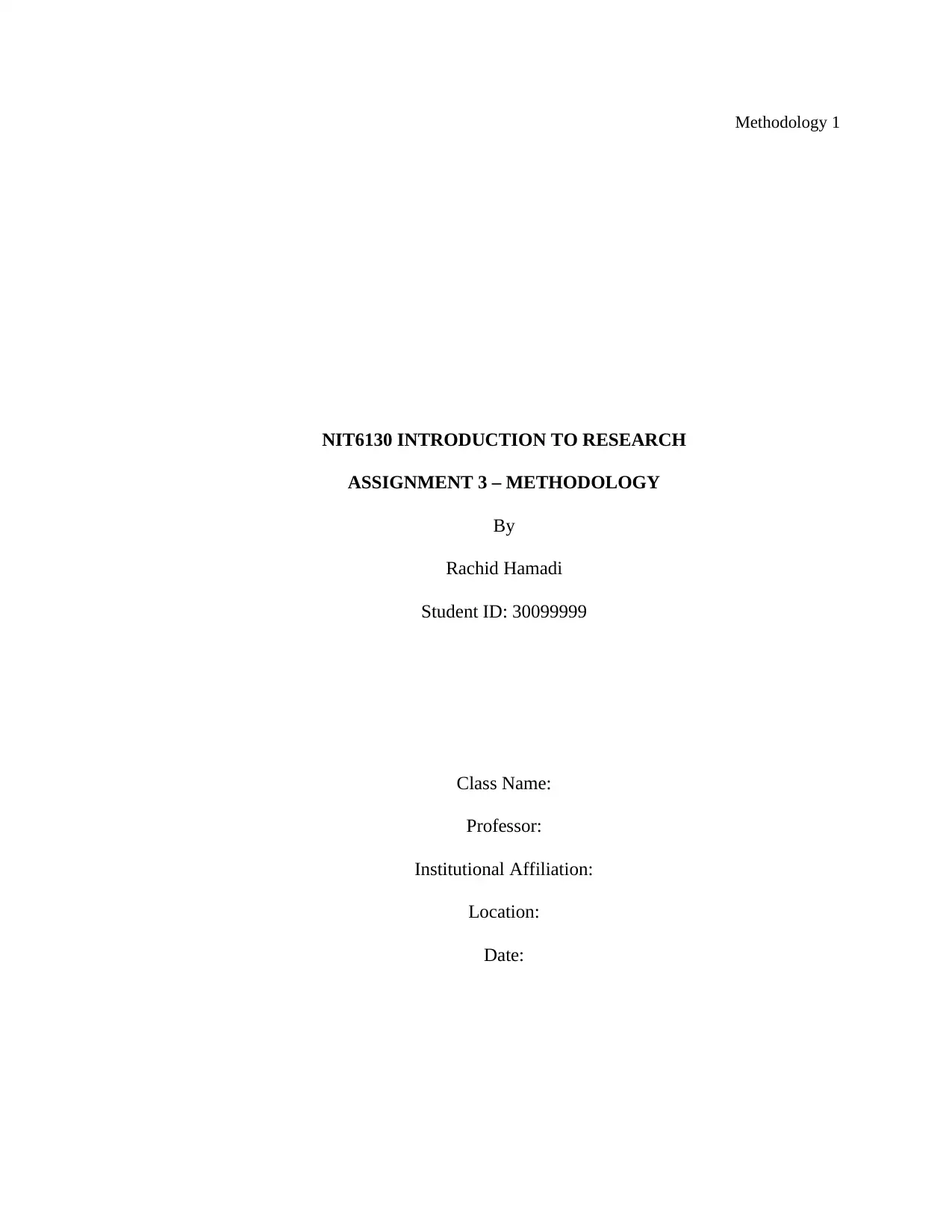
Methodology 1
NIT6130 INTRODUCTION TO RESEARCH
ASSIGNMENT 3 – METHODOLOGY
By
Rachid Hamadi
Student ID: 30099999
Class Name:
Professor:
Institutional Affiliation:
Location:
Date:
NIT6130 INTRODUCTION TO RESEARCH
ASSIGNMENT 3 – METHODOLOGY
By
Rachid Hamadi
Student ID: 30099999
Class Name:
Professor:
Institutional Affiliation:
Location:
Date:
Paraphrase This Document
Need a fresh take? Get an instant paraphrase of this document with our AI Paraphraser
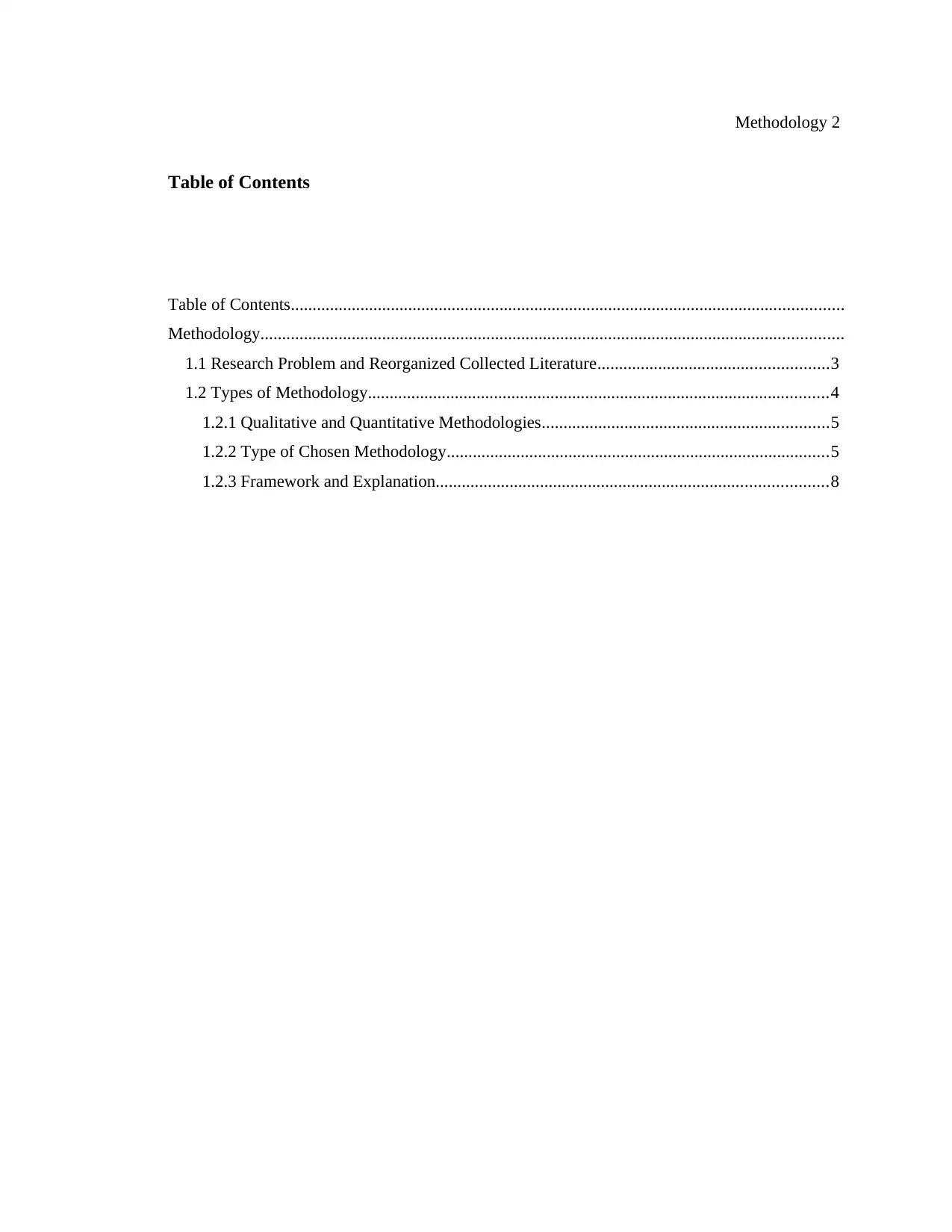
Methodology 2
Table of Contents
Table of Contents...............................................................................................................................
Methodology......................................................................................................................................
1.1 Research Problem and Reorganized Collected Literature.....................................................3
1.2 Types of Methodology..........................................................................................................4
1.2.1 Qualitative and Quantitative Methodologies..................................................................5
1.2.2 Type of Chosen Methodology........................................................................................5
1.2.3 Framework and Explanation..........................................................................................8
Table of Contents
Table of Contents...............................................................................................................................
Methodology......................................................................................................................................
1.1 Research Problem and Reorganized Collected Literature.....................................................3
1.2 Types of Methodology..........................................................................................................4
1.2.1 Qualitative and Quantitative Methodologies..................................................................5
1.2.2 Type of Chosen Methodology........................................................................................5
1.2.3 Framework and Explanation..........................................................................................8

Methodology 3
⊘ This is a preview!⊘
Do you want full access?
Subscribe today to unlock all pages.

Trusted by 1+ million students worldwide
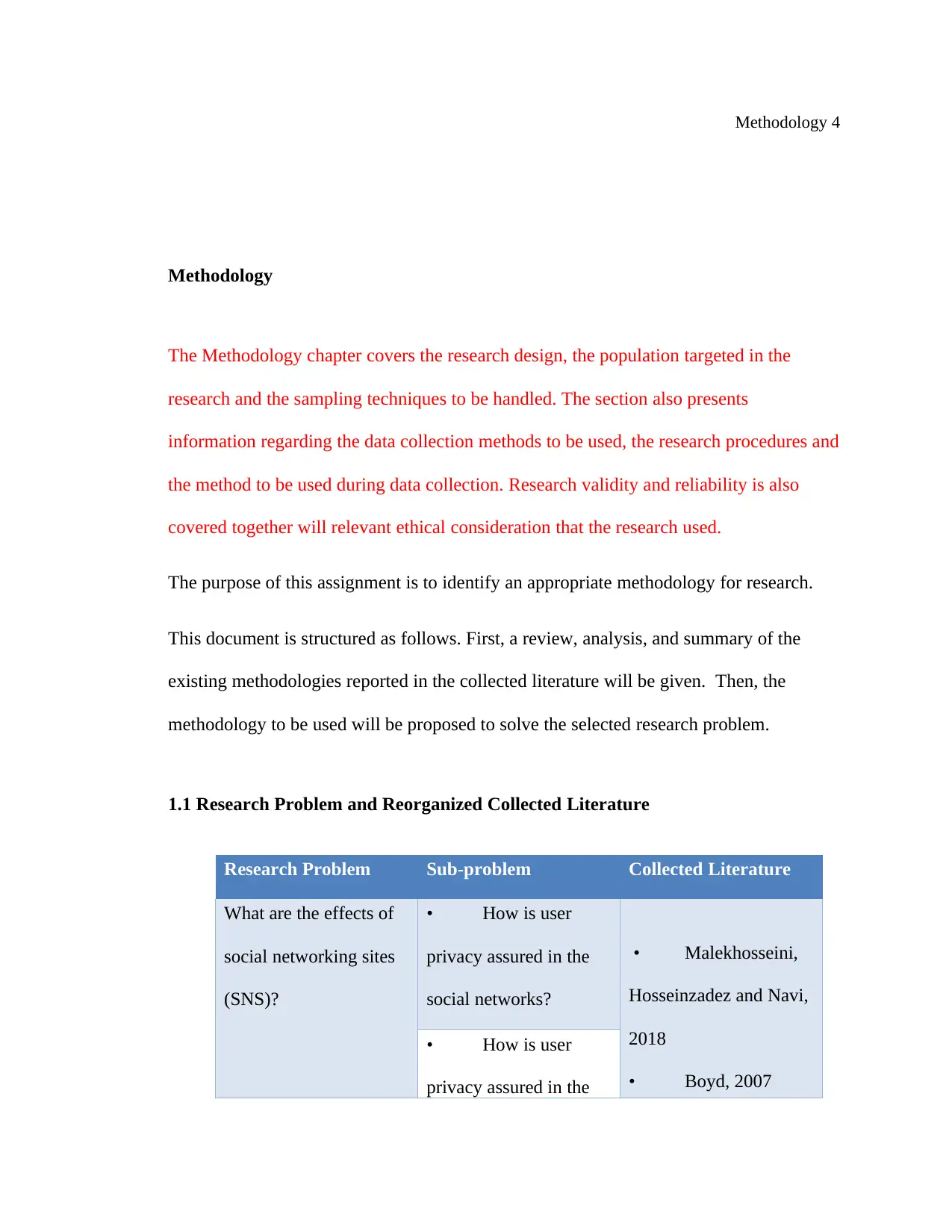
Methodology 4
Methodology
The Methodology chapter covers the research design, the population targeted in the
research and the sampling techniques to be handled. The section also presents
information regarding the data collection methods to be used, the research procedures and
the method to be used during data collection. Research validity and reliability is also
covered together will relevant ethical consideration that the research used.
The purpose of this assignment is to identify an appropriate methodology for research.
This document is structured as follows. First, a review, analysis, and summary of the
existing methodologies reported in the collected literature will be given. Then, the
methodology to be used will be proposed to solve the selected research problem.
1.1 Research Problem and Reorganized Collected Literature
Research Problem Sub-problem Collected Literature
What are the effects of
social networking sites
(SNS)?
• How is user
privacy assured in the
social networks?
• Malekhosseini,
Hosseinzadez and Navi,
2018
• Boyd, 2007
• How is user
privacy assured in the
Methodology
The Methodology chapter covers the research design, the population targeted in the
research and the sampling techniques to be handled. The section also presents
information regarding the data collection methods to be used, the research procedures and
the method to be used during data collection. Research validity and reliability is also
covered together will relevant ethical consideration that the research used.
The purpose of this assignment is to identify an appropriate methodology for research.
This document is structured as follows. First, a review, analysis, and summary of the
existing methodologies reported in the collected literature will be given. Then, the
methodology to be used will be proposed to solve the selected research problem.
1.1 Research Problem and Reorganized Collected Literature
Research Problem Sub-problem Collected Literature
What are the effects of
social networking sites
(SNS)?
• How is user
privacy assured in the
social networks?
• Malekhosseini,
Hosseinzadez and Navi,
2018
• Boyd, 2007
• How is user
privacy assured in the
Paraphrase This Document
Need a fresh take? Get an instant paraphrase of this document with our AI Paraphraser
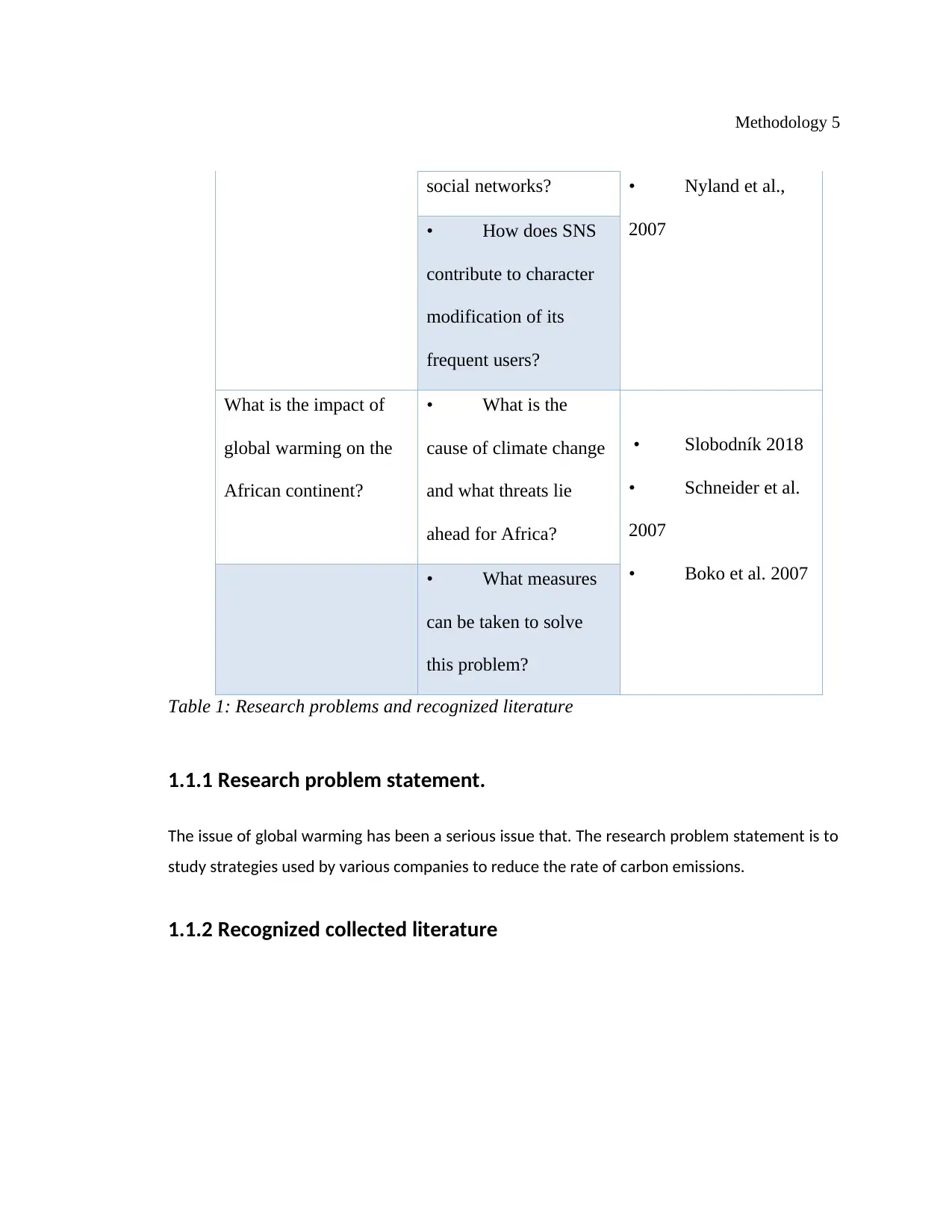
Methodology 5
social networks? • Nyland et al.,
2007• How does SNS
contribute to character
modification of its
frequent users?
What is the impact of
global warming on the
African continent?
• What is the
cause of climate change
and what threats lie
ahead for Africa?
• Slobodník 2018
• Schneider et al.
2007
• Boko et al. 2007• What measures
can be taken to solve
this problem?
Table 1: Research problems and recognized literature
1.1.1 Research problem statement.
The issue of global warming has been a serious issue that. The research problem statement is to
study strategies used by various companies to reduce the rate of carbon emissions.
1.1.2 Recognized collected literature
social networks? • Nyland et al.,
2007• How does SNS
contribute to character
modification of its
frequent users?
What is the impact of
global warming on the
African continent?
• What is the
cause of climate change
and what threats lie
ahead for Africa?
• Slobodník 2018
• Schneider et al.
2007
• Boko et al. 2007• What measures
can be taken to solve
this problem?
Table 1: Research problems and recognized literature
1.1.1 Research problem statement.
The issue of global warming has been a serious issue that. The research problem statement is to
study strategies used by various companies to reduce the rate of carbon emissions.
1.1.2 Recognized collected literature
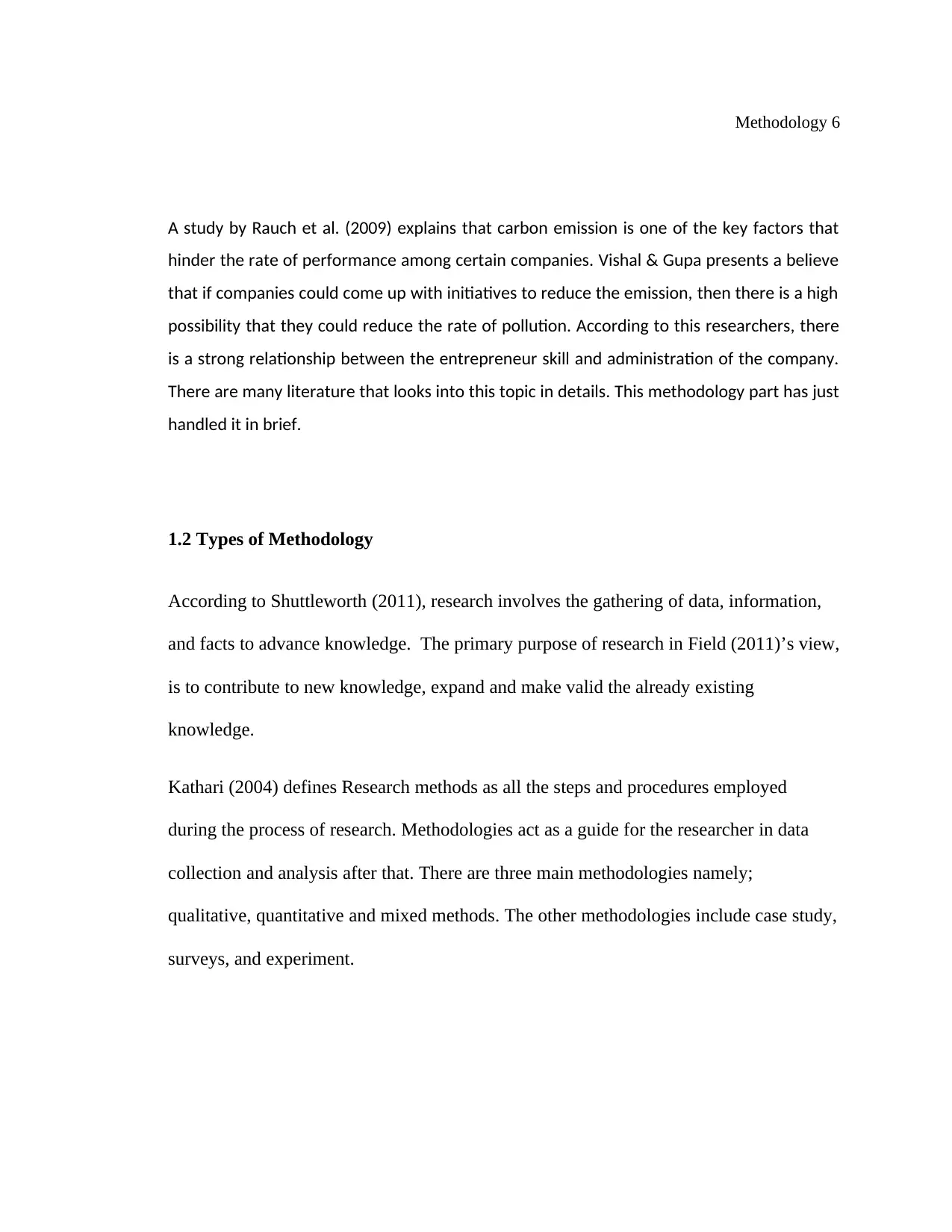
Methodology 6
A study by Rauch et al. (2009) explains that carbon emission is one of the key factors that
hinder the rate of performance among certain companies. Vishal & Gupa presents a believe
that if companies could come up with initiatives to reduce the emission, then there is a high
possibility that they could reduce the rate of pollution. According to this researchers, there
is a strong relationship between the entrepreneur skill and administration of the company.
There are many literature that looks into this topic in details. This methodology part has just
handled it in brief.
1.2 Types of Methodology
According to Shuttleworth (2011), research involves the gathering of data, information,
and facts to advance knowledge. The primary purpose of research in Field (2011)’s view,
is to contribute to new knowledge, expand and make valid the already existing
knowledge.
Kathari (2004) defines Research methods as all the steps and procedures employed
during the process of research. Methodologies act as a guide for the researcher in data
collection and analysis after that. There are three main methodologies namely;
qualitative, quantitative and mixed methods. The other methodologies include case study,
surveys, and experiment.
A study by Rauch et al. (2009) explains that carbon emission is one of the key factors that
hinder the rate of performance among certain companies. Vishal & Gupa presents a believe
that if companies could come up with initiatives to reduce the emission, then there is a high
possibility that they could reduce the rate of pollution. According to this researchers, there
is a strong relationship between the entrepreneur skill and administration of the company.
There are many literature that looks into this topic in details. This methodology part has just
handled it in brief.
1.2 Types of Methodology
According to Shuttleworth (2011), research involves the gathering of data, information,
and facts to advance knowledge. The primary purpose of research in Field (2011)’s view,
is to contribute to new knowledge, expand and make valid the already existing
knowledge.
Kathari (2004) defines Research methods as all the steps and procedures employed
during the process of research. Methodologies act as a guide for the researcher in data
collection and analysis after that. There are three main methodologies namely;
qualitative, quantitative and mixed methods. The other methodologies include case study,
surveys, and experiment.
⊘ This is a preview!⊘
Do you want full access?
Subscribe today to unlock all pages.

Trusted by 1+ million students worldwide
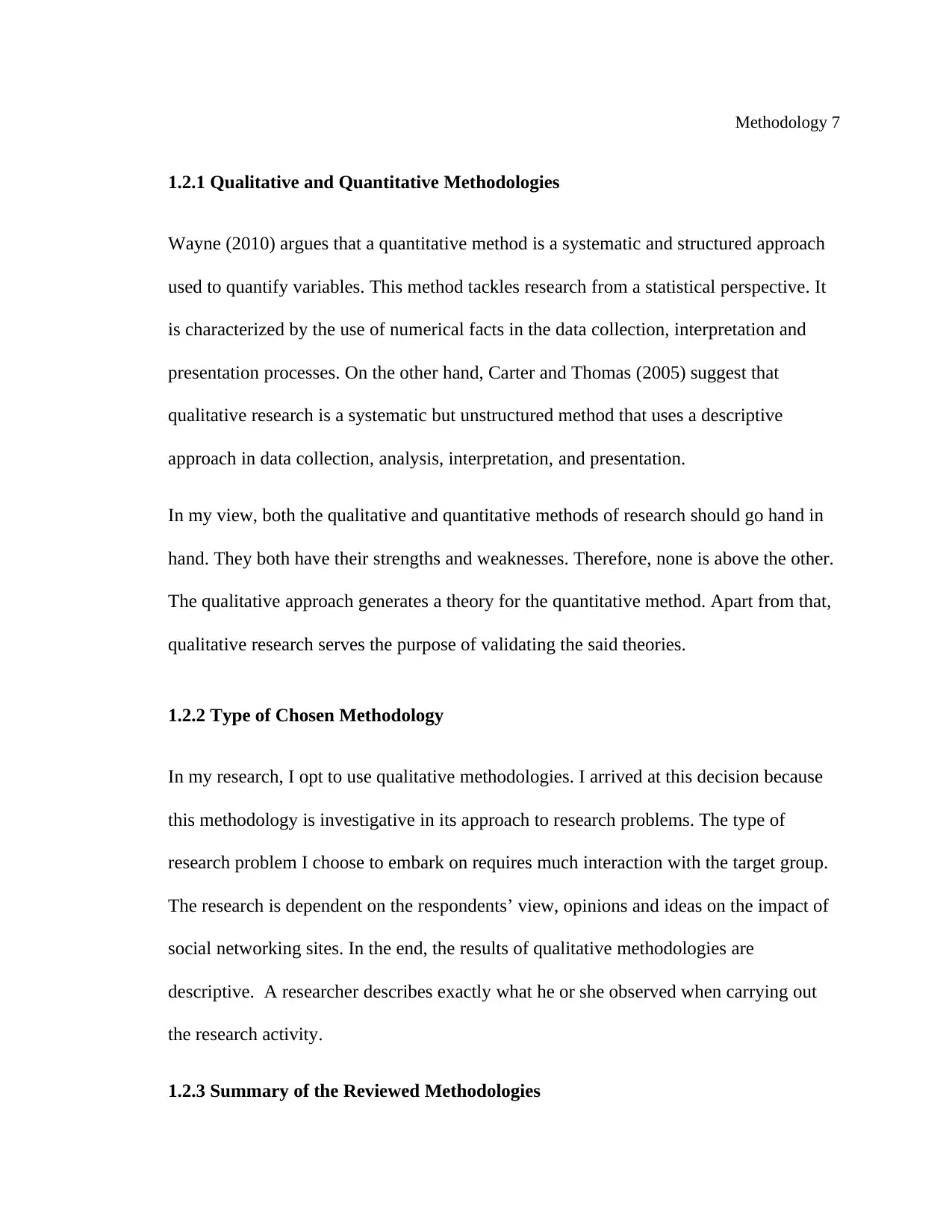
Methodology 7
1.2.1 Qualitative and Quantitative Methodologies
Wayne (2010) argues that a quantitative method is a systematic and structured approach
used to quantify variables. This method tackles research from a statistical perspective. It
is characterized by the use of numerical facts in the data collection, interpretation and
presentation processes. On the other hand, Carter and Thomas (2005) suggest that
qualitative research is a systematic but unstructured method that uses a descriptive
approach in data collection, analysis, interpretation, and presentation.
In my view, both the qualitative and quantitative methods of research should go hand in
hand. They both have their strengths and weaknesses. Therefore, none is above the other.
The qualitative approach generates a theory for the quantitative method. Apart from that,
qualitative research serves the purpose of validating the said theories.
1.2.2 Type of Chosen Methodology
In my research, I opt to use qualitative methodologies. I arrived at this decision because
this methodology is investigative in its approach to research problems. The type of
research problem I choose to embark on requires much interaction with the target group.
The research is dependent on the respondents’ view, opinions and ideas on the impact of
social networking sites. In the end, the results of qualitative methodologies are
descriptive. A researcher describes exactly what he or she observed when carrying out
the research activity.
1.2.3 Summary of the Reviewed Methodologies
1.2.1 Qualitative and Quantitative Methodologies
Wayne (2010) argues that a quantitative method is a systematic and structured approach
used to quantify variables. This method tackles research from a statistical perspective. It
is characterized by the use of numerical facts in the data collection, interpretation and
presentation processes. On the other hand, Carter and Thomas (2005) suggest that
qualitative research is a systematic but unstructured method that uses a descriptive
approach in data collection, analysis, interpretation, and presentation.
In my view, both the qualitative and quantitative methods of research should go hand in
hand. They both have their strengths and weaknesses. Therefore, none is above the other.
The qualitative approach generates a theory for the quantitative method. Apart from that,
qualitative research serves the purpose of validating the said theories.
1.2.2 Type of Chosen Methodology
In my research, I opt to use qualitative methodologies. I arrived at this decision because
this methodology is investigative in its approach to research problems. The type of
research problem I choose to embark on requires much interaction with the target group.
The research is dependent on the respondents’ view, opinions and ideas on the impact of
social networking sites. In the end, the results of qualitative methodologies are
descriptive. A researcher describes exactly what he or she observed when carrying out
the research activity.
1.2.3 Summary of the Reviewed Methodologies
Paraphrase This Document
Need a fresh take? Get an instant paraphrase of this document with our AI Paraphraser
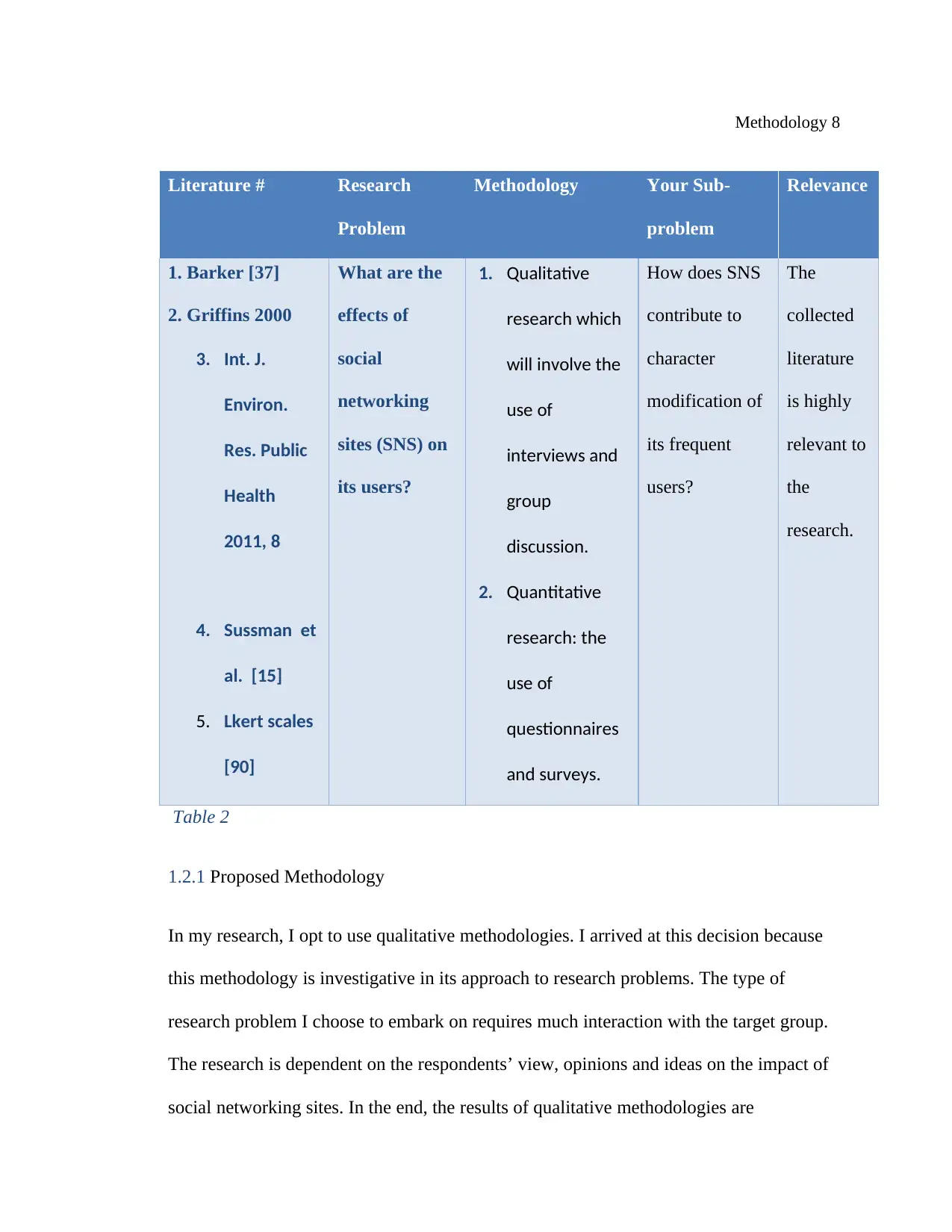
Methodology 8
Literature # Research
Problem
Methodology Your Sub-
problem
Relevance
1. Barker [37]
2. Griffins 2000
3. Int. J.
Environ.
Res. Public
Health
2011, 8
4. Sussman et
al. [15]
5. Lkert scales
[90]
What are the
effects of
social
networking
sites (SNS) on
its users?
1. Qualitative
research which
will involve the
use of
interviews and
group
discussion.
2. Quantitative
research: the
use of
questionnaires
and surveys.
How does SNS
contribute to
character
modification of
its frequent
users?
The
collected
literature
is highly
relevant to
the
research.
Table 2
1.2.1 Proposed Methodology
In my research, I opt to use qualitative methodologies. I arrived at this decision because
this methodology is investigative in its approach to research problems. The type of
research problem I choose to embark on requires much interaction with the target group.
The research is dependent on the respondents’ view, opinions and ideas on the impact of
social networking sites. In the end, the results of qualitative methodologies are
Literature # Research
Problem
Methodology Your Sub-
problem
Relevance
1. Barker [37]
2. Griffins 2000
3. Int. J.
Environ.
Res. Public
Health
2011, 8
4. Sussman et
al. [15]
5. Lkert scales
[90]
What are the
effects of
social
networking
sites (SNS) on
its users?
1. Qualitative
research which
will involve the
use of
interviews and
group
discussion.
2. Quantitative
research: the
use of
questionnaires
and surveys.
How does SNS
contribute to
character
modification of
its frequent
users?
The
collected
literature
is highly
relevant to
the
research.
Table 2
1.2.1 Proposed Methodology
In my research, I opt to use qualitative methodologies. I arrived at this decision because
this methodology is investigative in its approach to research problems. The type of
research problem I choose to embark on requires much interaction with the target group.
The research is dependent on the respondents’ view, opinions and ideas on the impact of
social networking sites. In the end, the results of qualitative methodologies are
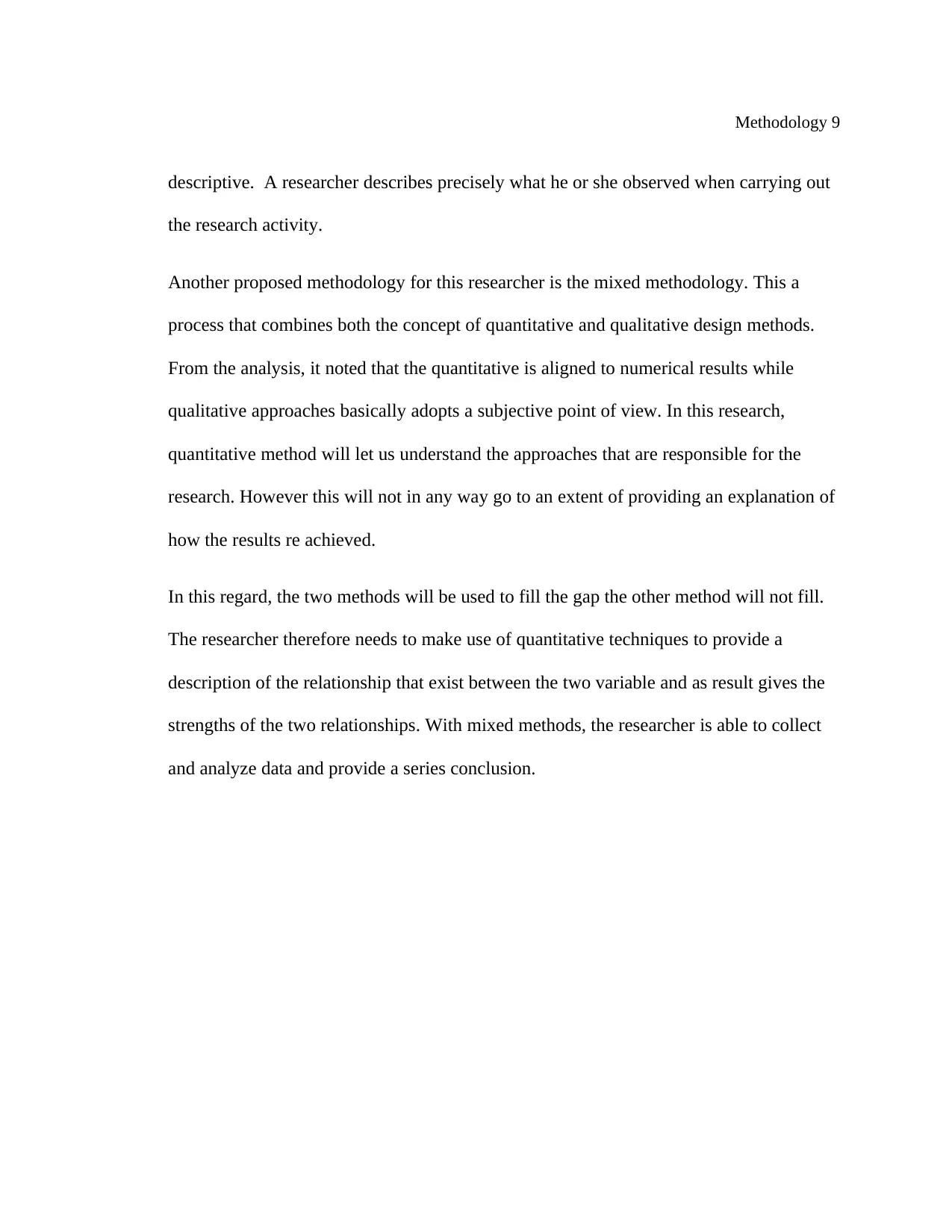
Methodology 9
descriptive. A researcher describes precisely what he or she observed when carrying out
the research activity.
Another proposed methodology for this researcher is the mixed methodology. This a
process that combines both the concept of quantitative and qualitative design methods.
From the analysis, it noted that the quantitative is aligned to numerical results while
qualitative approaches basically adopts a subjective point of view. In this research,
quantitative method will let us understand the approaches that are responsible for the
research. However this will not in any way go to an extent of providing an explanation of
how the results re achieved.
In this regard, the two methods will be used to fill the gap the other method will not fill.
The researcher therefore needs to make use of quantitative techniques to provide a
description of the relationship that exist between the two variable and as result gives the
strengths of the two relationships. With mixed methods, the researcher is able to collect
and analyze data and provide a series conclusion.
descriptive. A researcher describes precisely what he or she observed when carrying out
the research activity.
Another proposed methodology for this researcher is the mixed methodology. This a
process that combines both the concept of quantitative and qualitative design methods.
From the analysis, it noted that the quantitative is aligned to numerical results while
qualitative approaches basically adopts a subjective point of view. In this research,
quantitative method will let us understand the approaches that are responsible for the
research. However this will not in any way go to an extent of providing an explanation of
how the results re achieved.
In this regard, the two methods will be used to fill the gap the other method will not fill.
The researcher therefore needs to make use of quantitative techniques to provide a
description of the relationship that exist between the two variable and as result gives the
strengths of the two relationships. With mixed methods, the researcher is able to collect
and analyze data and provide a series conclusion.
⊘ This is a preview!⊘
Do you want full access?
Subscribe today to unlock all pages.

Trusted by 1+ million students worldwide
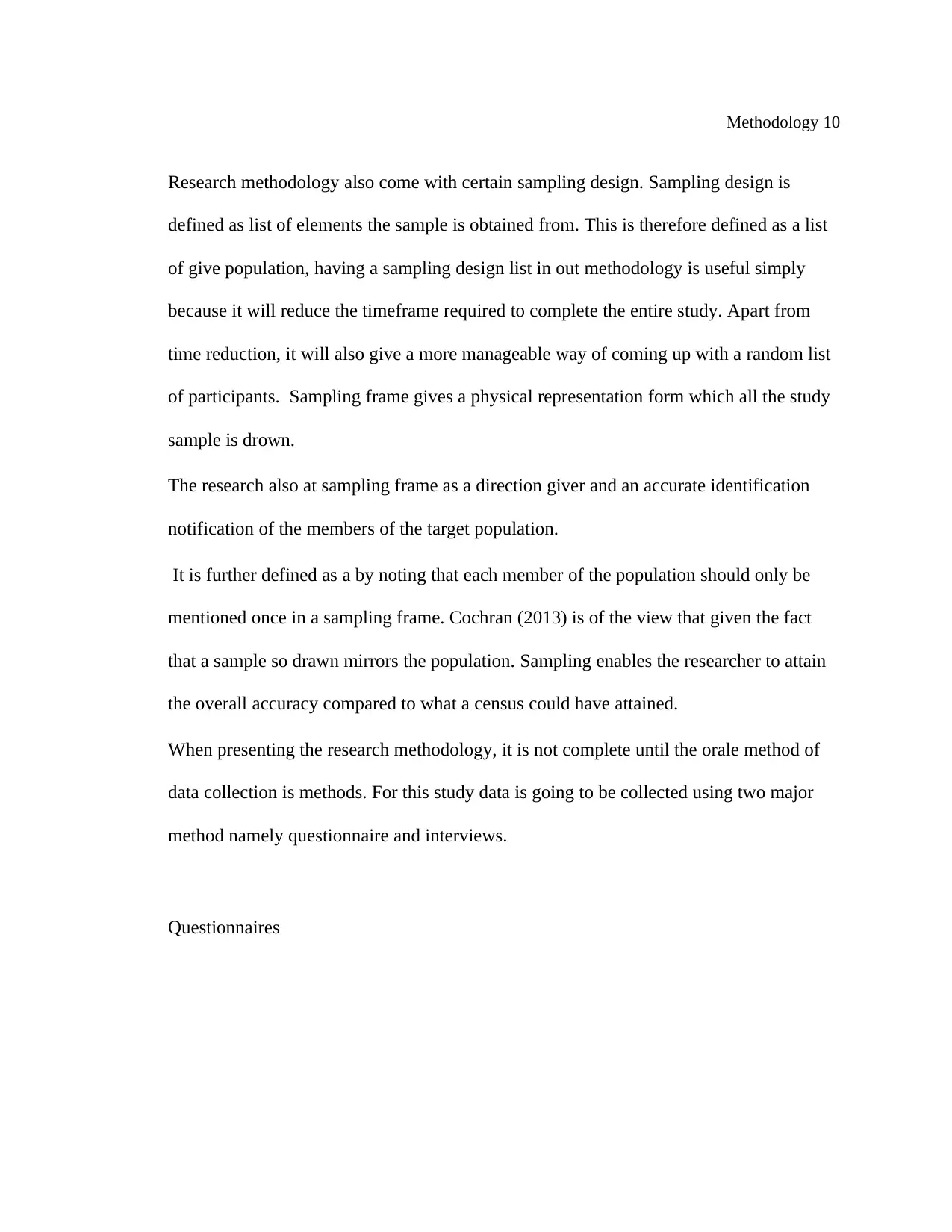
Methodology 10
Research methodology also come with certain sampling design. Sampling design is
defined as list of elements the sample is obtained from. This is therefore defined as a list
of give population, having a sampling design list in out methodology is useful simply
because it will reduce the timeframe required to complete the entire study. Apart from
time reduction, it will also give a more manageable way of coming up with a random list
of participants. Sampling frame gives a physical representation form which all the study
sample is drown.
The research also at sampling frame as a direction giver and an accurate identification
notification of the members of the target population.
It is further defined as a by noting that each member of the population should only be
mentioned once in a sampling frame. Cochran (2013) is of the view that given the fact
that a sample so drawn mirrors the population. Sampling enables the researcher to attain
the overall accuracy compared to what a census could have attained.
When presenting the research methodology, it is not complete until the orale method of
data collection is methods. For this study data is going to be collected using two major
method namely questionnaire and interviews.
Questionnaires
Research methodology also come with certain sampling design. Sampling design is
defined as list of elements the sample is obtained from. This is therefore defined as a list
of give population, having a sampling design list in out methodology is useful simply
because it will reduce the timeframe required to complete the entire study. Apart from
time reduction, it will also give a more manageable way of coming up with a random list
of participants. Sampling frame gives a physical representation form which all the study
sample is drown.
The research also at sampling frame as a direction giver and an accurate identification
notification of the members of the target population.
It is further defined as a by noting that each member of the population should only be
mentioned once in a sampling frame. Cochran (2013) is of the view that given the fact
that a sample so drawn mirrors the population. Sampling enables the researcher to attain
the overall accuracy compared to what a census could have attained.
When presenting the research methodology, it is not complete until the orale method of
data collection is methods. For this study data is going to be collected using two major
method namely questionnaire and interviews.
Questionnaires
Paraphrase This Document
Need a fresh take? Get an instant paraphrase of this document with our AI Paraphraser
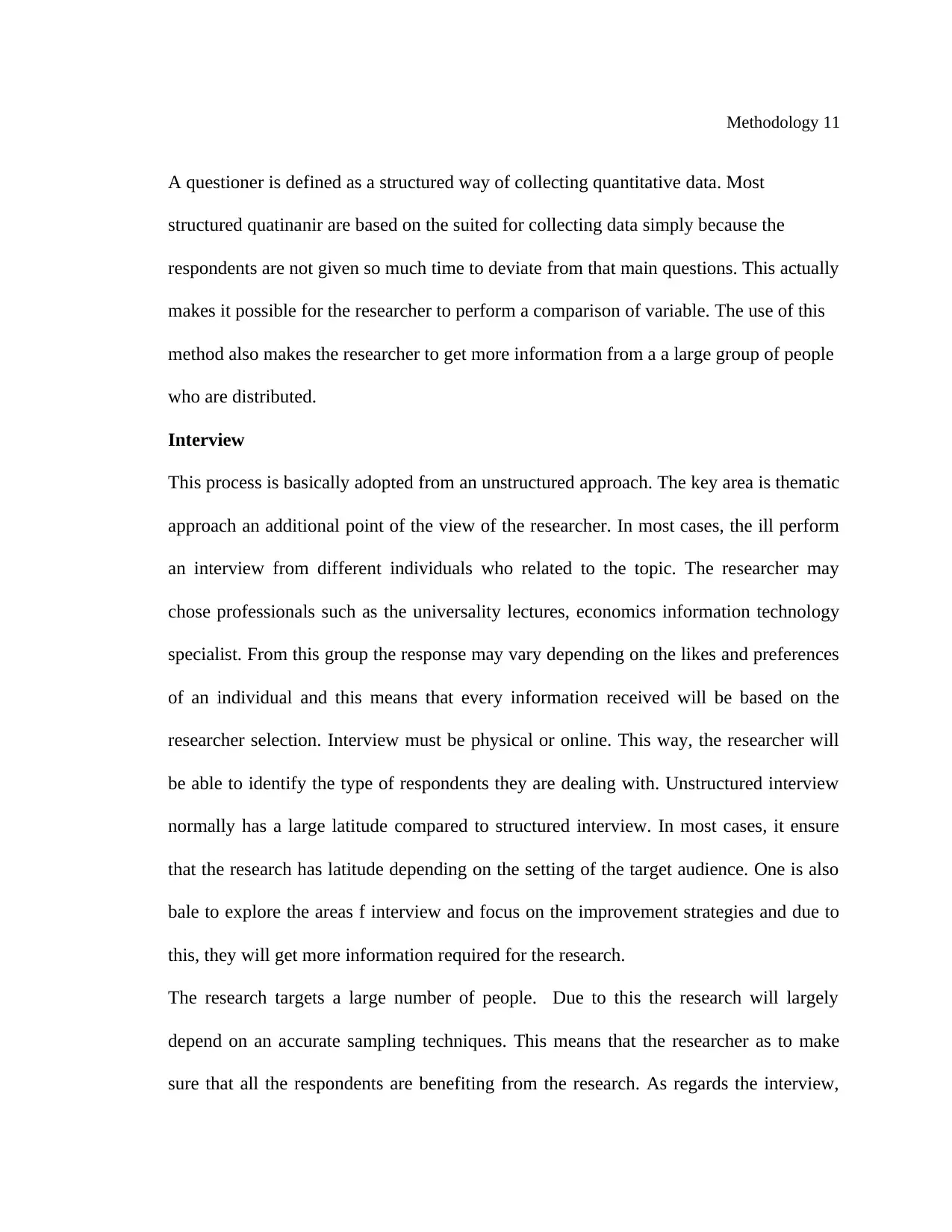
Methodology 11
A questioner is defined as a structured way of collecting quantitative data. Most
structured quatinanir are based on the suited for collecting data simply because the
respondents are not given so much time to deviate from that main questions. This actually
makes it possible for the researcher to perform a comparison of variable. The use of this
method also makes the researcher to get more information from a a large group of people
who are distributed.
Interview
This process is basically adopted from an unstructured approach. The key area is thematic
approach an additional point of the view of the researcher. In most cases, the ill perform
an interview from different individuals who related to the topic. The researcher may
chose professionals such as the universality lectures, economics information technology
specialist. From this group the response may vary depending on the likes and preferences
of an individual and this means that every information received will be based on the
researcher selection. Interview must be physical or online. This way, the researcher will
be able to identify the type of respondents they are dealing with. Unstructured interview
normally has a large latitude compared to structured interview. In most cases, it ensure
that the research has latitude depending on the setting of the target audience. One is also
bale to explore the areas f interview and focus on the improvement strategies and due to
this, they will get more information required for the research.
The research targets a large number of people. Due to this the research will largely
depend on an accurate sampling techniques. This means that the researcher as to make
sure that all the respondents are benefiting from the research. As regards the interview,
A questioner is defined as a structured way of collecting quantitative data. Most
structured quatinanir are based on the suited for collecting data simply because the
respondents are not given so much time to deviate from that main questions. This actually
makes it possible for the researcher to perform a comparison of variable. The use of this
method also makes the researcher to get more information from a a large group of people
who are distributed.
Interview
This process is basically adopted from an unstructured approach. The key area is thematic
approach an additional point of the view of the researcher. In most cases, the ill perform
an interview from different individuals who related to the topic. The researcher may
chose professionals such as the universality lectures, economics information technology
specialist. From this group the response may vary depending on the likes and preferences
of an individual and this means that every information received will be based on the
researcher selection. Interview must be physical or online. This way, the researcher will
be able to identify the type of respondents they are dealing with. Unstructured interview
normally has a large latitude compared to structured interview. In most cases, it ensure
that the research has latitude depending on the setting of the target audience. One is also
bale to explore the areas f interview and focus on the improvement strategies and due to
this, they will get more information required for the research.
The research targets a large number of people. Due to this the research will largely
depend on an accurate sampling techniques. This means that the researcher as to make
sure that all the respondents are benefiting from the research. As regards the interview,
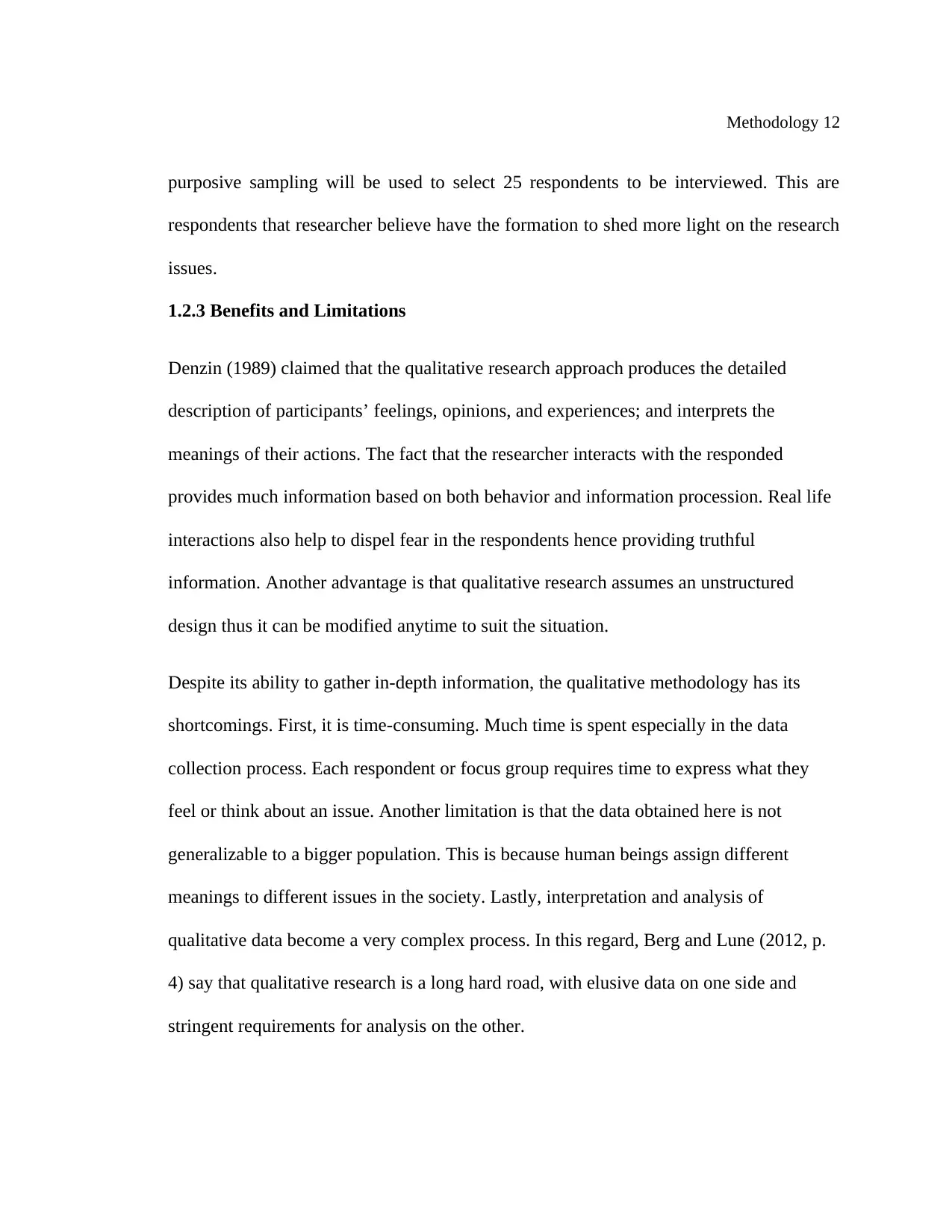
Methodology 12
purposive sampling will be used to select 25 respondents to be interviewed. This are
respondents that researcher believe have the formation to shed more light on the research
issues.
1.2.3 Benefits and Limitations
Denzin (1989) claimed that the qualitative research approach produces the detailed
description of participants’ feelings, opinions, and experiences; and interprets the
meanings of their actions. The fact that the researcher interacts with the responded
provides much information based on both behavior and information procession. Real life
interactions also help to dispel fear in the respondents hence providing truthful
information. Another advantage is that qualitative research assumes an unstructured
design thus it can be modified anytime to suit the situation.
Despite its ability to gather in-depth information, the qualitative methodology has its
shortcomings. First, it is time-consuming. Much time is spent especially in the data
collection process. Each respondent or focus group requires time to express what they
feel or think about an issue. Another limitation is that the data obtained here is not
generalizable to a bigger population. This is because human beings assign different
meanings to different issues in the society. Lastly, interpretation and analysis of
qualitative data become a very complex process. In this regard, Berg and Lune (2012, p.
4) say that qualitative research is a long hard road, with elusive data on one side and
stringent requirements for analysis on the other.
purposive sampling will be used to select 25 respondents to be interviewed. This are
respondents that researcher believe have the formation to shed more light on the research
issues.
1.2.3 Benefits and Limitations
Denzin (1989) claimed that the qualitative research approach produces the detailed
description of participants’ feelings, opinions, and experiences; and interprets the
meanings of their actions. The fact that the researcher interacts with the responded
provides much information based on both behavior and information procession. Real life
interactions also help to dispel fear in the respondents hence providing truthful
information. Another advantage is that qualitative research assumes an unstructured
design thus it can be modified anytime to suit the situation.
Despite its ability to gather in-depth information, the qualitative methodology has its
shortcomings. First, it is time-consuming. Much time is spent especially in the data
collection process. Each respondent or focus group requires time to express what they
feel or think about an issue. Another limitation is that the data obtained here is not
generalizable to a bigger population. This is because human beings assign different
meanings to different issues in the society. Lastly, interpretation and analysis of
qualitative data become a very complex process. In this regard, Berg and Lune (2012, p.
4) say that qualitative research is a long hard road, with elusive data on one side and
stringent requirements for analysis on the other.
⊘ This is a preview!⊘
Do you want full access?
Subscribe today to unlock all pages.

Trusted by 1+ million students worldwide
1 out of 17
Related Documents
Your All-in-One AI-Powered Toolkit for Academic Success.
+13062052269
info@desklib.com
Available 24*7 on WhatsApp / Email
![[object Object]](/_next/static/media/star-bottom.7253800d.svg)
Unlock your academic potential
Copyright © 2020–2025 A2Z Services. All Rights Reserved. Developed and managed by ZUCOL.





